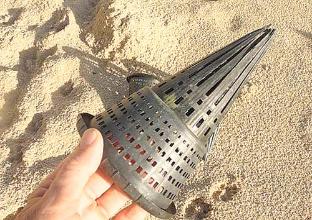Published in the Ocean Watch column, Honolulu Star-Advertiser © Susan Scott
August 9, 2010

“What are those things?” a man asked, pointing to a hanging decoration I made from some plastic junk I found on the beach. “I see them in the sand all the time, but I can’t think what they’re for.”
The man was referring to plastic mesh cones shaped like dunce caps. The cones are black, about 8 inches long and 5 inches across at the open end. The closed end consists of 16 flexible strips that come together to a point.
It’s easy to see how an eellike fish could swim into the wide end of this cone, push through the movable strips and not be able to swim back out. And that’s the point. These cones are the entryways to hagfish traps.
By all accounts, hagfish are slimy, ugly and creepy, yet these odd fish are much loved. Evolutionary biologists who study links between animals with and without backbones believe hagfish might be the last living example of the ancient animals that gave rise to fish and humans.
About 60 species of hagfish live at all depths of all the world’s temperate oceans, from intertidal zones to 15,000 feet deep. Hagfish are so primitive, they’re barely fish, lacking jaws, eyesight and fins as we know them. A hagfish has a rear fin, but it’s so fleshy these creatures were once classified as worms.
Hagfish are formidable predators, burrowing into sand and sediment as they hunt for live shrimp, crabs, snails and worms.
These fish are better known, though, for feeding on dead and dying marine animals in a manner that could inspire a horror movie. The narrow, 25-inch-long fish attacks carcasses in writhing swarms, wiggling inside through the mouth, the anus or a wound. Once there the hagfish eats everything soft, leaving a heap of skin-covered bones.
Since injured fish attract hagfish, they sometimes invade fishing nets and devastate valuable catches. That’s bad enough for anglers, but hagfish also secrete copious amounts of sticky mucus when they’re disturbed, fouling boat decks and fishers with slime.
This protein substance is an effective defense for the fish, which can shroud itself in seconds. After the danger passes, the fish ties itself in a knot and then moves the knot down the length of its body to push off its mucus coat.
I’ve never seen a hagfish, but YouTube has some good videos. My favorite is called “Eddie and the Hagfish” from a Scripps Institution of Oceanography lab .
The biologists in this clip respect their hagfish, but twice made me smile when they call the revolting mucus the term that everyone thinks of when they see it: snot.
Hagfish meat, considered an aphrodisiac in Korea, is a delicacy there. The skins of hagfish are also prized. Koreans process and sell them as “eel skin” for boots, purses and belts. As a result of this lucrative market, anglers of various nations, including the U.S., fish for hagfish in the Atlantic and Pacific.
A typical hagfish angler sinks between 20 and 200 hagfish traps at a time in deep water. Sometimes, lines break and the barrel, pot or cylinder is lost. To prevent loose containers from becoming ghost traps, the entry cones have biodegradable fasteners that allow the cones to detach from the trap. These “doorways” float to the surface and eventually drift onto our beaches.
This is a rare case where marine plastic pollution isn’t all bad. Detached cones on our beaches mean that loose containers can’t catch and kill marine animals indefinitely.
When washed and painted, the cones also make good mobiles.